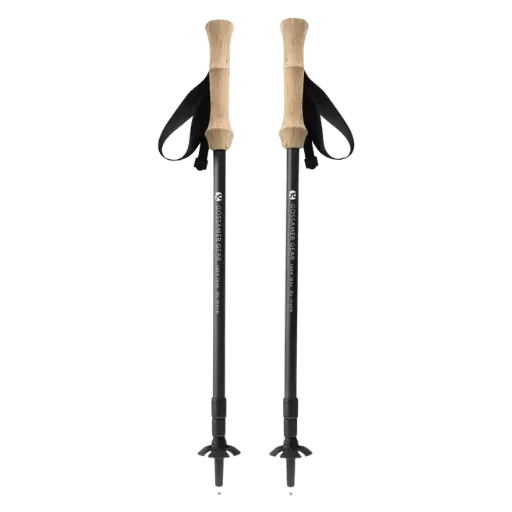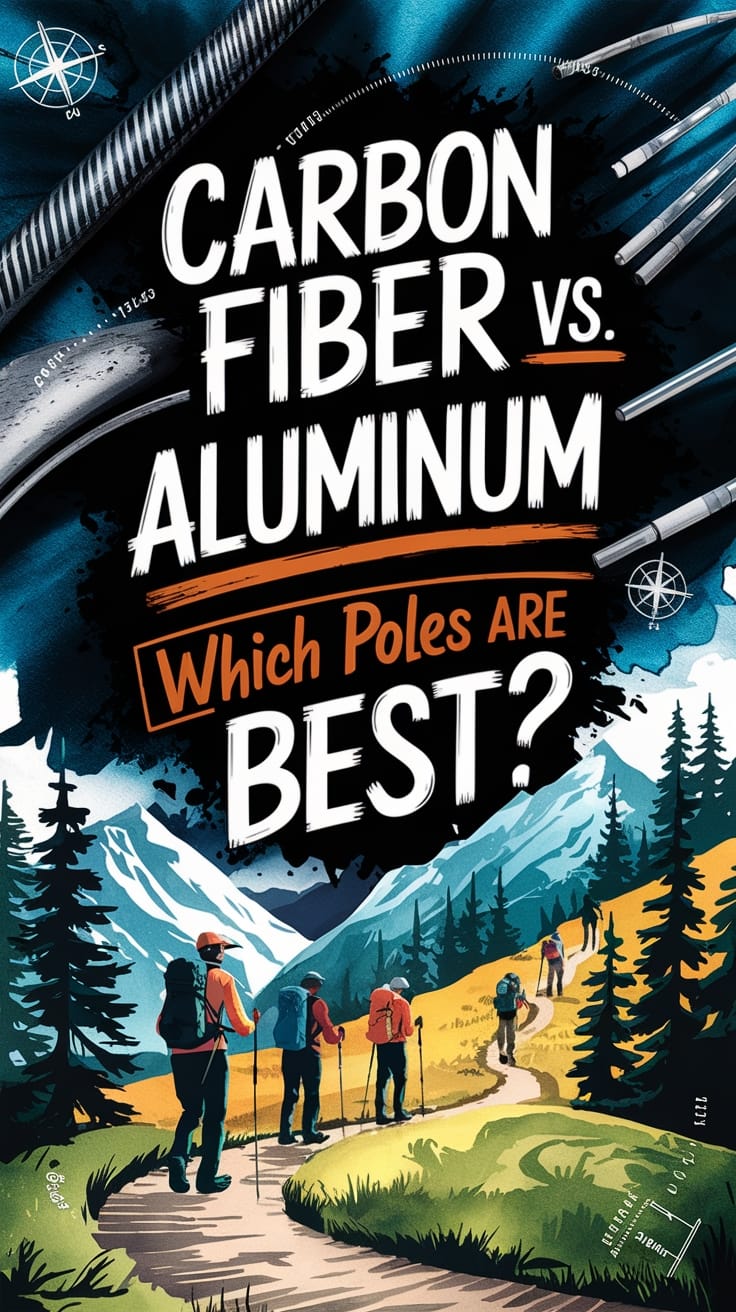Choosing trekking poles is often a hard choice for new hikers, we will focus today on carbon fiber vs aluminum trekking poles to provide you details helping you make your decision.
Let's look into each and help you make a knowledgeable decision to help get you out on the trails as soon as possible! First, we consider why these two are discussed so heavily and then dig into the benefits and drawbacks.
The Importance of Trekking Poles
Trekking poles are helpful as they aid in easy movement and help to distribute your backpack's weight by reducing the load on your lower body.
This is especially useful when you are thru-hiking and traveling over longer distances or for those with back, hips, or knees issues.
Poles also serve as additional support should you trip or fall, which can help prevent injuries. They help to control motion when heading downhill and also can be used to test the depth of water or muddy areas.
Trekking poles are an essential part of any hiker's gear, especially for those who intend on taking consistent regular backpacking trips, especially on rough terrain.
Lastly, some non-freestanding tents need poles to give them structure; these trekking pole tents are some of the lightest shelters you can get with complete enclosure from the elements!
Now we can get into the benefits and drawbacks of each, and we will start with the more expensive carbon fiber as they are the gold standard for thru-hikers.
The Pros and Cons of Carbon Fiber
There are many benefits of trekking poles, and carbon fiber offers some fantastic advantages and some limited issues versus aluminum; let's look at each individually:
Carbon Fibers' Advantages
There is certain advantages in using the incredible carbon fiber material, it lends amazing rigidity and much more!
Exceptional Quality
Carbon fiber is incredibly strong for its weight and also has very little give. This makes it the perfect material for those who need a lot of support while backpacking but don't want the extra weight.
Amazingly Comfortable
Since they are rigid and have very little in the way of give, this makes them very comfortable as they don't shift and move around as you walk. In addition, for some, this may also mean they are much less likely to rub your skin raw as well.
Very Supportive
They provide an exceptional level of support for your body. This is extremely important for those carrying a lot of weight or have issues with their hips, back, and knees.
The very lightweight carbon fiber helps to take some of the pressure off of these problem areas.
Incredibly Lightweight
When you want to reduce the amount of weight you carry, ultralight poles like carbon fiber are the way to go.
They help to take a lot of weight off arms so movement is faster and this faster movement helps kick you down the trail much easier.
Carbon Fibers' Disadvantages
Some issues I feel that exist with carbon fiber is horrible versus side impacts as it can break down the bonds that construct it, let's look at these terminal issues:
More Expensive
The process of making carbon fiber isn't cheap, and then you have to attach all the handles, tips, and baskets which also costs money. This means carbon fiber trekking poles will be more expensive than aluminum.
Very Fragile and Can Shatter
They can be very susceptible to side impacts and if they are bent the wrong direction they can snap and give out in the middle of use when they are the most important.
Any slight sideways motion instead of up and down can lead to broken and useless poles at the worst times.
The Pros and Cons of Aluminum

While carbon fiber is an amazing use of technology, the tried and true aluminum is a good purchase for many but it also comes with some good qualities and some bad qualities we can discuss:
Aluminum Advantages
At its core, aluminum is an excellent metal that has a lot of good qualities we can touch on:
Can Be Used When Bent
Unlike carbon fiber which shatters leaving you a splintered mess to carry out aluminum will bend and is still viable to use. Granted it isn't going to be as useful but in a pinch, it could save your life.
Can Be Re-Straightened
Additionally, with the above, you can straighten many aluminum poles back out so they are usable again. This isn't possible with carbon fiber, as once it snaps, there is no coming back from that.
More Durable
Overall, aluminum makes for a more durable trekking pole, especially in awkward side-to-side bending, like when it goes to the side of a rock when heading downhill.
This sideways stress aluminum handles like a champ where almost all CF will break under stress.
Inexpensive
The process of making aluminum isn't as expensive as carbon fiber, meaning the final product will be cheaper.
This is excellent news for those looking for a bargain or those who don't want to spend much money on their trekking poles.
Aluminum Disadvantages
There is some bad news about using a pair of aluminum poles, and here they are:
Not as Rigid
Aluminum isn't nearly as rigid as carbon fiber, so it doesn't have the same support level. This can be an issue for those with injuries or older age as the added support can be beneficial.
Aluminum Is Heavier
The weight of aluminum will be noticeably higher than carbon fiber which can make a difference when you are out on the trail all day.
This can add up for thru-hikers as you stack days to months on the trail.
Prone to Vibrations
Aluminum transfers vibrations much more than carbon fiber, leading to fatigue in your arms and hands over time.
This is especially true on rocky or root-filled trails, which dominate much of the American forested trails.
Carbon vs Aluminum at a Glance
| Aluminum (Best) | Carbon Fiber (Best) | |
|---|---|---|
| Weight | x | |
| Toughness | x | |
| Reliability | x | x (Top Tier Only) |
| Price | x | |
| Comfort | x |
When to Choose Carbon Fiber
The lower-cost "budget" carbon fiber is a good starter for someone looking to improve from the aluminum poles but the more expensive high-quality carbon fiber is really prominent for ultralight hikers and thru-hikers.
Additionally, many carbon fiber poles come in at well under 1 pound per pair, which helps keep the total carried weight down as well.
When to Choose Aluminum
Aluminum trekking poles are good for those on a budget or those who don't want to spend a lot on poles, so its a perfect option for new hikers and people trying to see if they enjoy the hobby itself before diving in hard.
In addition, aluminum is good for those who are hard on poles which can be in movement itself or if you are a taller or heavier person.
High Quality Trekking Pole Options

Durston Gear Iceline Trekking Poles
The Iceline poles use a unique weight efficient design to create a trekking pole that is lighter, stronger, and more reliable.

Black Diamond Trail Cork Trekking Poles
The X-Mid Pro 2 represents the peak of ultralight tent design. Featuring the stormworthy X-Mid geometry combined with a single-wall design, this tent is both ultra-light and highly capable.

Gossamer Gear LT5 Carbon Trekking Poles
One of the most portable poles available, LT5s are some of the lightest 3-piece poles on the planet.
Final Thoughts on Carbon Fiber vs Aluminum Trekking Poles
Whether you are a cork grips kind of person like myself or a person who prefers EVA foam grips, your trekking poles will be friends on a longer thru-hike and are a good investment for your overall comfort.
Aluminum is an intelligent purchase for budget and new hikers to start with as they are going to be very forgiving if you accidentally drop them or bang them on a rock.
They are also great for those that might be taller or heavier, as they can handle more weight and abuse.
On the flip side, when looking for max performance and aren't overly cruel to your poles, a carbon fiber pole will drop significant ounces per pair of poles while also increasing comfort.
So what's it going to be? Are you team aluminum or carbon fiber? Do you prefer fixed-length poles, collapsible poles, or foldable poles? What is your preferred type of trekking pole?
Let me know in the comments below!







